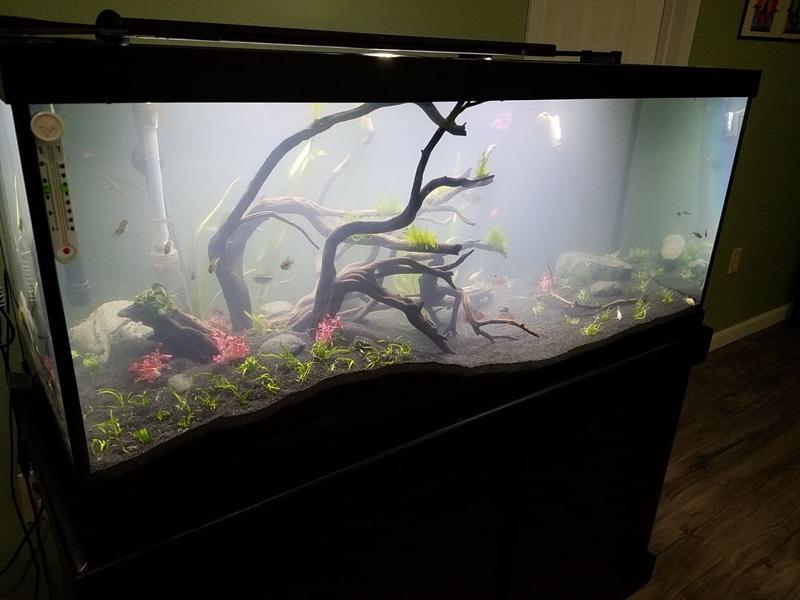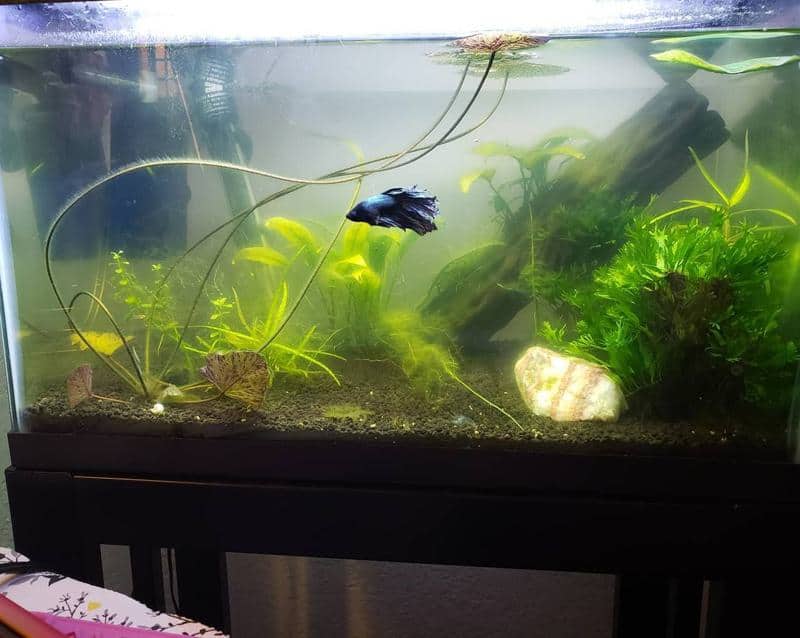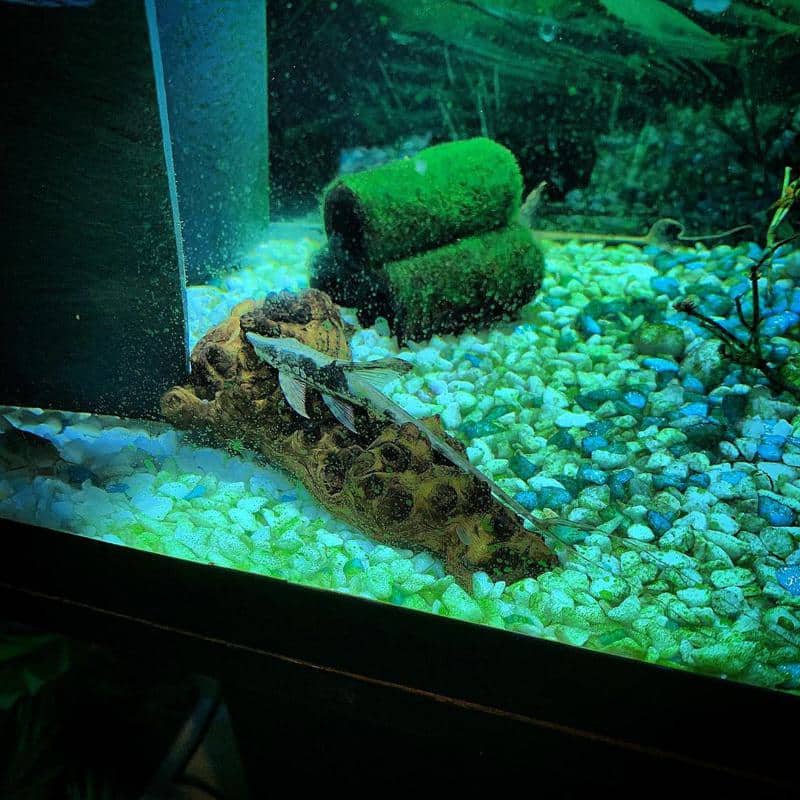Few things make aquarium keepers more proud than a crystal clear aquarium filled with vibrant fish, lush plants, and a beautiful scape.
However, there’s one problem that many aquarists face: cloudiness. Cloudiness in a tank can obscure the view and prevent you from admiring the beauty of your hard work.
Luckily, in this article, we’ve got solutions to your problem. Whether you’re a beginner seeking to establish a thriving aquarium or a seasoned fishkeeper looking to solve recurring cloudiness, we’ve got your back.
Let’s talk about what causes your tank water to be cloudy and what you can do about it!
5 Reasons Why Your Fish Tank is Cloudy

Wondering why your fish tank looks cloudy? Here are five of the most common reasons why!
Uncycled Tank
So, you’ve just finished setting up a new tank. Everything looks great. But then, when you wake up the next morning, you realize that your aquarium has turned into a cloudy mess overnight. The worst part is that no matter how many times you change the water, it seems like the cloudiness just keeps coming back.
If this sounds familiar, then you’re likely suffering from new tank syndrome.
New tank syndrome is the term given to the cloudiness that occurs in new tanks. It’s typically caused by all the bacteria in your tank that are only starting to establish themselves.
Here’s a not-so-fun fact: just because it’s called “new tank syndrome” doesn’t mean it only occurs in new tanks. In some cases, it may occur days, weeks, or even months after you’ve set up your aquarium, as long as it hasn’t fully cycled yet.
What Causes New Tank Syndrome?
A new tank is like basically a new home for bacteria. That may sound bad, but that’s actually exactly what we want: for beneficial bacteria to make their home in our fish tanks.
That said, the process doesn’t always go smoothly. The bacteria don’t always get along with each other.
Think of these resulting bacteria as new renters who, while they themselves don’t cause any harm to your tank, may cause a ruckus while settling into the new environment.
They’ve got moving boxes, plenty of stuff to organize, and furniture to set up. They’re not familiar with your place yet, so they may get lost on their way to the kitchen or accidentally press the wrong buttons in the garage.
Add new, unfamiliar roommates to the mix, and there’s bound to be some misunderstandings, disagreements, and—in the case of a fish tank—plenty of cloudiness.
How to Solve New Tank Syndrome
So, how exactly do you fix a new tank syndrome? The answer is simple: Patience! Your tank is going through a biological cycle that needs time to complete itself.
In other words, it’s cleaning up after all those new housemates, and it can get really messy before it becomes better.
That’s why we always recommend letting your tank fully cycle first before you add any fish. While fish-in cycles are possible, putting your fish in an uncycled tank is still a big risk. There are all sorts of toxins and bacteria that can harm your fish, so it’s best to wait until the cycle is complete before you add them.
You can also add nitrifying bacteria like FritzZyme 7 Nitrifying Bacteria to your tank to help speed things along or borrow a friend’s old sponge filter or gravel to jumpstart your cycle.
Substrate Residues
If the cloudiness occurs right after you’ve filled up your tank with water, it could be because of your substrate, specifically its residues.
Aquarium substrate may not seem that important compared to other factors involved in fishkeeping, but it actually is. Not only does it provide a place for your to grow live plants, but it also provides a surface for beneficial bacteria to take up residence in your tank.
That’s why picking the right substrate, and knowing how to properly set it up in your tank, is absolutely vital.
How Does Substrate Cause Cloudiness?
Substrates can cause cloudiness in your tank because of all the dust and loose particles in the material, particularly for brand-new substrates.
These particles can be stirred up easily by even a gentle current. As they remain suspended in the water column, the water will look white and cloudy. The time it takes for the water in your aquarium to become clear again after disturbing the substrate depends on how much debris is stirred up and how long it takes for the particles to settle back down.
How to Solve Cloudiness from Substrates
The solution depends on whether the substrate you’re using is new or old.
- For new substrates: If you’re using a brand new substrate straight from its packaging, you should wash it thoroughly with tap water until the water becomes clear. Doing this ensures that all the dust and debris from the substrate is removed and won’t be present in your tank.
- For used substrates: If your substrate isn’t new but it’s still causing your water to become cloudy after a water change, it’s probably just loose particles. You can use a siphon to suck up all these particles. This should clear up your water in no time.
That said, keep in mind that not all substrates should be washed. Some substrates specifically say on the packaging that they shouldn’t be washed, or else they’ll break down and make the water black.
One of the most notorious culprits for this is ADA Amazonia, an aqua soil that can turn your tank black if you wash it or even touch it incorrectly.
For these types of substrates, our tip is to use a gentle stream of water to fill up your tank. You can also use a piece of plastic to cover the substrate. This should help keep your water clear without compromising the substrate’s integrity.
Dirty Water

Dirty water is one of the most common causes of cloudy water in fish tanks. However, it’s not always easy to notice because it doesn’t always look cloudy right away.
The trouble with dirty water is that it’s full of organic matter, like bits of food, decaying plants, and waste from animals. When these things break down, they release harmful substances such as ammonia and other toxins into your tank. These pollutants can seriously harm your fish.
Not only that, but they can also make the water cloudy and even give off an unpleasant odor from your tank.
What Causes Dirty Water?
- Uneaten food. Uneaten fish food causes a buildup of organic matter inside the tank, which breaks down and releases harmful toxins into the water. Over time, the tank becomes a breeding ground for bacteria and other organisms. As they multiply, some of them will stay in the water column, making the water look cloudy.
- Too many fish in your tank can also be problematic because each fish equals a certain amount of waste. This means that having a lot of fish means that you’ll also have a lot of waste. All this waste will dirty up the water, causing it to become cloudy.
- Infrequent water changes. Water changes are a vital part of your tank’s maintenance routine since they remove excess waste in the tank and introduce fresh, clean water. Skipping out on these regular water changes will eventually lead to dirty water, which results in a cloudy tank.
How to Solve Dirty Water
The solution depends on what causes your dirty water in the first place. Here are a few tips you can do to solve a dirty water problem causing cloudiness in your tank.
- Reduce the number of tank inhabitants. Reducing your tank’s population will also reduce the amount of waste produced inside your aquarium. This will help keep your water clean for longer periods of time and also free up some space in the tank.
- Only feed them what they can eat in a minute. Overfeeding your fish is one of the most common causes of dirty aquarium water. By only feeding your fish what they can eat in a minute, you can be sure that there won’t be any uneaten food left in the tank.
- Scoop out uneaten food. If you’ve already given your fish some food and they end up not eating everything you give them, you should use a small net or scooper to remove the uneaten food before it decomposes.
- Get a better filter. Increasing your filter’s flow rate can help remove more debris from the water column before it can decompose and cloud up your tank.
- Change the water regularly. The best way to keep your tank clean and clear is to do regular water changes. By regularly sucking out a portion of the old water and putting in fresh, clean water, you can eliminate whatever toxins and pollutants are causing cloudiness inside your aquarium.
Heavy Metals or Elements
Heavy metals and other elements like silicates and phosphates can also cause cloudy water in your aquarium.
Interestingly, tap water often contains these substances, albeit in very small concentrations.
However, there are certain regions in the world where water filtration may not be sufficient enough. And in these areas, the concentrations of heavy metals in tap water can be higher — high enough to cause damage to your fish tank.
The sad part is that humans are partly to blame for this issue. Pollution from industrial waste, agricultural runoffs, and other sources have contributed to a rise in toxic metals in the environment. If we’re not careful, these contaminants can find their way into our home aquariums.
That’s why we need to take steps to ensure the water we use in our tanks is clean and free from excessive amounts of these substances.
How Can Heavy Metals or Elements Cause Cloudy Water?
There are many ways that heavy metals or elements can cause cloudiness in your aquarium.
For one, they can cause turbidity, which is when particles in the water scatter and reflect light. When there’s a high level of turbidity, that means there are also plenty of particles in the water. This will make it look cloudy or hazy.
Two, a large amount of metals in the water can also affect its pH. Changes in the water’s pH can have an effect on the growth of beneficial bacteria. As mentioned above, disruptions in this balance can reduce water clarity and lead to a cloudy tank.
And three, certain heavy metals, such as copper, can also act as a micronutrient for algae growth. When there’s too much copper in your tank, they can stimulate excessive algal growth, leading to cloudy water.
How to Solve Cloudy Water from Heavy Metals and Elements
If you think you have contaminants in your water, the easiest way to get rid of them is by using a high-quality water conditioner like Seachem Prime, API Tap Water Aquarium, and Tetra AquaSafe Plus, every time you do a water change.
These conditioners will help remove metals or elements present in your tap water. Of course, if the water is already cloudy, don’t forget to change it first before adding in conditioner.
Also, one thing to note is that your problem may go beyond just cloudy water — heavy metals can also make your fish sick and even kill them in high concentrations.
So, if you’re always having a problem related to metals or elements in your tap water, you may want to consider using reverse osmosis water, also known as RO water.
Additionally, regular testing with API Freshwater Master Test Kit, proper filtration, and responsible water management should also help.
Dirty Aquarium Walls

This may seem like a silly question, but when was the last time you cleaned your aquarium walls?
Actually, dirty aquarium walls can also make the tank look cloudy. If you’re not in the habit of cleaning the walls, they can become coated with a thin layer of algae.
Not only can this contribute to the tank appearing hazy, but it can also cause particles to drop in the water, which can make it dirtier and lead to more cloudiness.
What Causes Dirty Aquarium Walls?
There are several potential causes of dirty aquarium walls, but the most common one is poor tank maintenance.
Poor tank maintenance doesn’t just mean infrequent water changes. Another tank on any good fishkeeper’s maintenance list is cleaning aquarium walls.
This is especially true for planted tanks that have live plants with leaves.
The reason for this is simple. Live plants shed dead leaves. Dead leaves can stick to your aquarium walls. If you don’t scrape or wipe them off, they can decompose right there and eventually cloud your water.
How to Solve Dirty Aquarium Walls
Dirty aquarium walls are, fortunately, not a difficult problem to solve. In fact, it’s super easy to deal with this issue. All you need is a soft, microfiber cloth that you can use to wipe the walls and remove any algae or dirty buildup.
You can also use algae scrapers like Aqueon Algae Cleaning Magnets and API Algae Scraper. The main purpose of these products is to help clean up your aquarium walls without making permanent scratches.
For more difficult stains, white vinegar is also a good choice. However, it can be dangerous to fish in large doses, so we recommend you empty your tank before attempting to clean it with vinegar.
If you’ve got a planted tank, trim your plants frequently and remove dead leaves sticking to the walls. The leaves may look fine for now, but they tend to leave behind residue. This can cause a stain on your aquarium walls, as well as make your water dirty.
Last but certainly not the least, don’t forget to clean the outside of your tank as well. Dust and other stains can accumulate on the outside of your tank.
Most algae scrapers have an outside component that also cleans the outside walls, but if you don’t have one, you can also use a damp microfiber cloth to wipe them down.
You can also add algae-eating tank mates like Siamese Algae Eaters, Plecos, shrimps, and snails to keep your aquarium walls clean and clear.
Also Read:
FAQs
What Is Turbidity?
Turbidity refers to how cloudy the water is due to particles found in it. A high turbidity means the water will look cloudy, while a low turbidity means it’s quite clear. Take note that while turbidity causes cloudiness, not all cloudiness is caused by turbidity.
Is a Cloudy Tank Harmful to Fish?
Depending on what’s causing the cloudy tank, it can be harmful to your fish. In many cases, it can even be fatal, so we recommend doing your best to identify and solve the problem immediately if you notice cloudy tank water.
Will a Cloudy Tank Clear on Its Own?
A cloudy tank can clear on its own in some situations. One of these is when your tank hasn’t fully cycled yet, and the beneficial bacteria still haven’t settled in yet. The other is when you’ve just changed your tank water and the substrate was disturbed. In these cases, the cloudiness should clear up on its own.
Should I Replace the Filter in My Cloudy Tank?
You shouldn’t replace the filter in your cloudy tank. If you think it’s dirty, rinse it using your old tank water instead during water changes. That’s because the filter is one of the places where beneficial bacteria in your aquarium live, so replacing it can reset your cycle.
Not to mention, replacing the filter likely won’t solve the problem anyway unless it’s broken and is no longer keeping your tank clean.
Conclusion
Now you understand what causes cloudy water in fish tanks and how you can solve it. Remember that the key to keeping a clean and beautiful tank is regular maintenance.
So, always stay on top of your water changes, monitor your tank parameters, and don’t forget to regularly check your fish for signs of illnesses or distress. By following the advice we listed above, we’re confident that you’ll be able to keep your tank crystal clear!